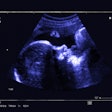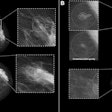The main immigrant groups served by screening programs should be mapped to increase attendance and address potential inequalities in healthcare delivery, according to a research group presenting findings from a Norwegian mammography program.
The team, led by Dr. Nataliia Moshina, PhD, a postdoctoral researcher at Cancer Registry of Norway (Kreftregisteret), noted that general recommendations for breast cancer screening do not consider women’s immigration status. However, several studies have shown substantially lower attendance for screening mammograms among immigrant women than for nonimmigrant women, particularly among immigrants from non-Western rather than Western countries. This disparity points to the potential for inequalities in healthcare access and delivery, the authors wrote in an ECR 2025 poster.
The study population included women who had been invited to participate in the BreastScreen Norway program between 2018 and 2023. The program offers all female residents ages 50 to 69 biennial screening mammography for €25. The women received an invitation letter listing a time and place for the screening examination and an information leaflet about breast cancer screening.
The invitation letter and leaflet have been available in Arabic, English, Polish, Somali, and Urdu on the Cancer Registry of Norway’s website since January 2021, the authors added.
To map the immigrant groups served by the BreastScreen Norway program, the research team extracted screening invitation and attendance data from the Cancer Registry database and followed the women from the month of the first screening invitation sent during the study period until the month of breast cancer diagnosis, emigration, death, or the end of the study period.
The team then classified all of the invited women into immigrant and nonimmigrant groups, with "immigrant" defined as having been born abroad. The women in the immigrant group were further subdivided into those born in Western countries and those born in non-Western countries.
Moshina and her colleagues defined Western countries as countries in Western Europe, North America, Australia, and New Zealand; non-Western countries included all other countries. The researchers then examined the data by group for the number of invitations to BreastScreen Norway and attendance following any invitation. They also mapped attendance trends for the groups.
Over the course of the study period, attendance increased from 77% to 80% among nonimmigrant women and from 62% to 68% among immigrant women born in Western countries; however, attendance remained unchanged at 49% among immigrant women born in non-Western countries. The authors also mapped trends in attendance over the period for the groups.
The findings showed that immigrant women, particularly those from non-Western countries, consistently had lower rates of attendance than nonimmigrant women for the BreastScreen Norway program screenings across the entire study period.
The authors suggested that the disparity in screening attendance for non-Western immigrant women might have been due in part to barriers these women faced with language, income, and obtaining patient guidance. In addition, differences in breast cancer awareness and health perception may have contributed to the notably low attendance rates for non-Western immigrant women.
To address these disparities -- and in turn perhaps mitigate the potential healthcare inequalities incurred as a result -- Moshina’s team recommended that qualitative assessments of the needs of women in the immigrant groups served by such screening programs should be carried out.
Read the full ECR 2025 poster here.



















